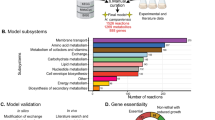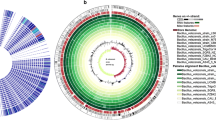Abstract
Sulphate-reducing bacteria are important players in the global sulphur and carbon cycles, with considerable economical and ecological impact. However, the process of sulphate respiration is still incompletely understood. Several mechanisms of energy conservation have been proposed, but it is unclear how the different strategies contribute to the overall process. In order to obtain a deeper insight into the energy metabolism of sulphate-reducers whole-genome microarrays were used to compare the transcriptional response of Desulfovibrio vulgaris Hildenborough grown with hydrogen/sulphate, pyruvate/sulphate, pyruvate with limiting sulphate, and lactate/thiosulphate, relative to growth in lactate/sulphate. Growth with hydrogen/sulphate showed the largest number of differentially expressed genes and the largest changes in transcript levels. In this condition the most up-regulated energy metabolism genes were those coding for the periplasmic [NiFeSe] hydrogenase, followed by the Ech hydrogenase. The results also provide evidence for the involvement of formate cycling and the recently proposed ethanol pathway during growth in hydrogen. The pathway involving CO cycling is relevant during growth on lactate and pyruvate, but not during growth in hydrogen as the most down-regulated genes were those coding for the CO-induced hydrogenase. Growth on lactate/thiosulphate reveals a down-regulation of several energy metabolism genes similar to what was observed in the presence of nitrite. This study identifies the role of several proteins involved in the energy metabolism of D. vulgaris and highlights several novel genes related to this process, revealing a more complex bioenergetic metabolism than previously considered.



Similar content being viewed by others
Abbreviations
- HS:
-
Hydrogen/sulphate medium
- LS:
-
Lactate/sulphate medium
- LT:
-
Lactate/thiosulphate medium
- PS:
-
Pyruvate/sulphate medium
- P:
-
Pyruvate medium
- SRB:
-
Sulphate-reducing bacteria
- TpIc3 :
-
Type I cytochrome c3
References
Badziong W, Bernhard D, Thauer RK (1979) Acetate and carbon dioxide assimilation by Desulfovibrio vulgaris (Marburg), growing on hydrogen and sulfate as sole energy source. Arch Microbiol 123:301–305
Badziong W, Thauer RK (1978) Growth yields and growth rates of Desulfovibrio vulgaris (Marburg) growing on hydrogen plus sulfate and hydrogen plus thiosulfate as the sole energy sources. Arch Microbiol 117:209–214
Caffrey SM, Park H-S, Voordouw JK, He Z, Zhou J, Voordouw G (2007) Function of periplasmic hydrogenases in the sulfate reducing bacterium Desulfovibrio vulgaris Hildenborough. J Bacteriol 189:6159–6167
Clark ME, He Q, He Z, Huang KH, Alm EJ, Wan XF, Hazen TC, Arkin AP, Wall JD, Zhou JZ, Fields MW (2006) Temporal transcriptomic analysis as Desulfovibrio vulgaris hildenborough transitions into stationary phase during electron donor depletion. Appl Environ Microbiol 72:5578–5588
Dinh HT, Kuever J, Mussmann M, Hassel AW, Stratmann M, Widdel F (2004) Iron corrosion by novel anaerobic microorganisms. Nature 427:829–832
Dolla A, Pohorelic BK, Voordouw JK, Voordouw G (2000) Deletion of the hmc operon of Desulfovibrio vulgaris subsp. vulgaris Hildenborough hampers hydrogen metabolism and low-redox-potential niche establishment. Arch Microbiol 174:143–151
Goenka A, Voordouw JK, Lubitz W, Gartner W, Voordouw G (2005) Construction of a [NiFe]-hydrogenase deletion mutant of Desulfovibrio vulgaris Hildenborough. Biochem Soc Trans 33:59–60
Hamilton WA (1998) Bioenergetics of sulphate-reducing bacteria in relation to their environmental impact. Biodegradation 9:201–212
Haveman SA, Brunelle V, Voordouw JK, Voordouw G, Heidelberg JF, Rabus R (2003) Gene expression analysis of energy metabolism mutants of Desulfovibrio vulgaris Hildenborough indicates an important role for alcohol dehydrogenase. J Bacteriol 185:4345–4353
Haveman SA, Greene EA, Stilwell CP, Voordouw JK, Voordouw G (2004) Physiological and gene expression analysis of inhibition of Desulfovibrio vulgaris Hildenborough by nitrite. J Bacteriol 186:7944–7950
He Q, Huang KH, He Z, Alm EJ, Fields MW, Hazen TC, Arkin AP, Wall JD, Zhou J (2006) Energetic Consequences of Nitrite Stress in Desulfovibrio vulgaris Hildenborough, Inferred from Global Transcriptional Analysis. Appl Environ Microbiol 72:4370–4381
Hedderich R, Forzi L (2005) Energy converting [NiFe] hydrogenases: more than just H2 activation. J Mol Microbiol Biotechnol 10:92–104
Heidelberg JF, Seshadri R, Haveman SA, Hemme CL, Paulsen IT, Kolonay JF, Eisen JA, Ward N, Methe B, Brinkac LM, Daugherty SC, Deboy RT, Dodson RJ, Durkin AS, Madupu R, Nelson WC, Sullivan SA, Fouts D, Haft DH, Selengut J, Peterson JD, Davidsen TM, Zafar N, Zhou LW, Radune D, Dimitrov G, Hance M, Tran K, Khouri H, Gill J, Utterback TR, Feldblyum TV, Wall JD, Voordouw G, Fraser CM (2004) The genome sequence of the anaerobic, sulfate-reducing bacterium Desulfovibrio vulgaris Hildenborough. Nat Biotechnol 22:554–559
Keon RG, Fu R, Voordouw G (1997) Deletion of two downstream genes alters expression of the hmc operon of Desulfovibrio vulgaris subsp. vulgaris Hildenborough. Arch Microbiol 167:376–383
Koo MS, Lee JH, Rah SY, Yeo WS, Lee JW, Lee KL, Koh YS, Kang SO, Roe JH (2003) A reducing system of the superoxide sensor SoxR in Escherichia coli. EMBO J 22:2614–2622
Lloyd JR (2003) Microbial reduction of metals and radionuclides. FEMS Microbiol Rev 27:411–425
Lupton FS, Conrad R, Zeikus JG (1984) Physiological function of hydrogen metabolism during growth of sulfidogenic bacteria on organic substrates. J Bacteriol 159:843–849
Magee EL, Ensley BD Jr, Barton LL (1978) An assessment of growth yields and energy coupling in Desulfovibrio. Arch Microbiol 117:21–26
Maroc J, Azerad R, Kamen MD, Le Gall J (1970) Menaquinone (MK-6) in the sulfate-reducing obligate anaerobe, Desulfovibrio. Biochim Biophys Acta 197:87–89
Meuer J, Kuettner HC, Zhang JK, Hedderich R, Metcalf WW (2002) Genetic analysis of the archaeon Methanosarcina barkeri Fusaro reveals a central role for Ech hydrogenase and ferredoxin in methanogenesis and carbon fixation. Proc Natl Acad Sci 99:5632–5637
Mukhopadhyay A, Redding A, Joachimiak MP, Arkin A, Borglin SC, Dehal PS, Chakraborty R, Geller JT, Hazen TC, He Q, Joyner DC, Martin VJJ, Wall J, Yang ZK, Keasling JD (2007) Cell wide responses to low oxygen exposure in Desulfovibrio vulgaris Hildenborough. J Bacteriol 189:5996–6010
Nie L, Wu G, Zhang W (2006) Correlation between mRNA and protein abundance in Desulfovibrio vulgaris: a multiple regression to identify sources of variations. Biochem Bioplys Res Commun 339:603–610
Odom JM, Peck HD (1981) Hydrogen cycling as a general mechanism for energy coupling in the sulphate-reducing bacterium Desulfovibrio sp. FEMS Microbiol Lett 12:47–50
Pankhania IP, Spormann AM, Hamilton WA, Thauer RK (1988) Lactate conversion to acetate, CO2 and H2 in cell-suspensions of Desulfovibrio vulgaris (Marburg) —Indications for the involvement of an energy driven reaction. Arch Microbiol 150:26–31
Pereira IAC, Haveman SA, Voordouw G (2007) Biochemical, genetic and genomic characterization of anaerobic electron transport pathways in sulphate-reducing delta-proteobacteria. In: Bolton LL, Hamilton WA (eds) Sulphate-reducing bacteria: environmental and engineered systems. Cambridge University Press, Cambridge, UK
Pereira IA, Romão CV, Xavier AV, Le Gall J, Teixeira M (1998) Electron transfer between hydrogenases and mono and multiheme cytochromes in Desulfovibrio spp. J Biol Inorg Chem 3:494–498
Pereira PM, Teixeira M, Xavier AV, Louro RO, Pereira IAC (2006) The Tmc complex from Desulfovibrio vulgaris Hildenborough is involved in transmembrane electron transfer from periplasmic hydrogen oxidation. Biochemistry 45:10359–10367
Pires RH, Lourenco AI, Morais F, Teixeira M, Xavier AV, Saraiva LM, Pereira IA (2003) A novel membrane-bound respiratory complex from Desulfovibrio desulfuricans ATCC 27774. Biochim Biophys Acta 1605:67–82
Pires RH, Venceslau SS, Morais F, Teixeira M, Xavier AV, Pereira IAC (2006) Characterization of the Desulfovibrio desulfuricans ATCC 27774 DsrMKJOP complex - a membrane-bound redox complex involved in sulfate respiration. Biochemistry 45:249–262
Pohorelic BK, Voordouw JK, Lojou E, Dolla A, Harder J, Voordouw G (2002) Effects of deletion of genes encoding Fe-only hydrogenase of Desulfovibrio vulgaris Hildenborough on hydrogen and lactate metabolism. J Bacteriol 184:679–686
Postgate JR (1984) The sulphate-reducing bacteria. Cambridge University Press, Cambridge, United Kingdom
Rabus R, Hansen T, Widdel F (2001) Dissimilatory sulfate- and sulfur-reducing prokaryotes. In: Dworkin M, Falkow S, Rosenberg E, Schleifer K-H, Stackebrandt E (eds) The prokaryotes: an evolving electronic resource for the microbiologic community [online]. Springer Science Online, Heidelberg, Germany
Rabus R, Ruepp A, Frickey T, Rattei T, Fartmann B, Stark M, Bauer M, Zibat A, Lombardot T, Becker I, Amann J, Gellner K, Teeling H, Leuschner WD, Glockner FO, Lupas AN, Amann R, Klenk HP (2004) The genome of Desulfotalea psychrophila, a sulfate-reducing bacterium from permanently cold Arctic sediments. Environ Microbiol 6:887–902
Rapp-Giles BJ, Casalot L, English RS, Ringbauer JA Jr, Dolla A, Wall JD (2000) Cytochrome c 3 mutants of Desulfovibrio desulfuricans. Appl Environ Microbiol 66:671–677
Rossi M, Pollock WB, Reij MW, Keon RG, Fu R, Voordouw G (1993) The hmc operon of Desulfovibrio vulgaris subsp. vulgaris Hildenborough encodes a potential transmembrane redox protein complex. J Bacteriol 175:4699–4711
Schmehl M, Jahn A, Vilsendorf AMZ, Hennecke S, Masepohl B, Schuppler M, Marxer M, Oelze J, Klipp W (1993) Identification of a new class of nitrogen-fixation genes in Rhodobacter capsulatus - a putative membrane complex involved in electron-transport to nitrogenase. Mol Gen Genet 241:602–615
Steuber J (2001) Na(+) translocation by bacterial NADH:quinone oxidoreductases: an extension to the complex-I family of primary redox pumps. Biochim Biophys Acta 1505:45–56
Tang Y, Pingitore F, Mukhopadhyay A, Phan R, Hazen TC, Keasling JD (2007) Pathway confirmation and flux analysis of central metabolic pathways in Desulfovibrio vulgaris Hildenborough using gas chromatography-mass spectrometry and Fourier transform-ion cyclotron resonance mass spectrometry. J Bacteriol 189:940–949
Tatusov RL, Fedorova ND, Jackson JD, Jacobs AR, Kiryutin B, Koonin EV, Krylov DM, Mazumder R, Mekhedov SL, Nikolskaya AN, Rao BS, Smirnov S, Sverdlov AV, Vasudevan S, Wolf YI, Yin JJ, Natale DA (2003) The COG database: an updated version includes eukaryotes. BMC Bioinformatics 4:41
Tatusov RL, Koonin EV, Lipman DJ (1997) A genomic perspective on protein families. Science 278:631–637
Traoré AS, Hatchikian CE, Belaich JP, Le Gall J (1981) Microcalorimetric studies of the growth of sulfate-reducing bacteria: energetics of Desulfovibrio vulgaris growth. J Bacteriol 145:191–199
Truper HG (1984) Phototrophic bacteria and their sulfur metabolism. In: Müller A, Krebs B (eds) Sulfur: its significance for chemistry, for the geo-, bio- and cosmophere, and technology. Elsevier, Amsterdam, pp 351–365
Valente FAA, Almeida CC, Pacheco I, Carita J, Saraiva LM, Pereira IAC (2006) Selenium is involved in regulation of periplasmic hydrogenase gene expression in Desulfovibrio vulgaris Hildenborough. J Bacteriol 188:3228–3235
Valente FM, Oliveira AS, Gnadt N, Pacheco I, Coelho AV, Xavier AV, Teixeira M, Soares CM, Pereira IA (2005) Hydrogenases in Desulfovibrio vulgaris Hildenborough: structural and physiologic characterisation of the membrane-bound [NiFeSe] hydrogenase. J Biol Inorg Chem 10:667–682
Valente FM, Saraiva LM, LeGall J, Xavier AV, Teixeira M, Pereira IA (2001) A membrane-bound cytochrome c 3: a type II cytochrome c 3 from Desulfovibrio vulgaris Hildenborough. Chembiochem 2:895–905
Voordouw G (2002) Carbon monoxide cycling by Desulfovibrio vulgaris Hildenborough. J Bacteriol 184:5903–5911
Wall JD, Krumholz LR (2006) Uranium Reduction. Ann Rev Microbiol 60:149–166
Wood PM (1978) A chemiosmotic model for sulphate respiration. FEBS Letts 95:12–18
Zhang W, Culley DE, Scholten JC, Hogan M, Vitiritti L, Brockman FJ (2006a) Global transcriptomic analysis of Desulfovibrio vulgaris on different electron donors. Antonie Van Leeuwenhoek 89:221–237
Zhang W, Gritsenko MA, Moore RJ, Culley DE, Nie L, Petritis K, Strittmatter EF, Camp DG II, Smith RD, Brockman FJ (2006b) A proteomic view of Desulfovibrio vulgaris metabolism as determined by liquid chromatography coupled with tandem mass spectrometry. Proteomics 6:4286–4299
Zhao T, Cruz F, Ferry JG (2001) Iron-sulfur flavoprotein (Isf) from Methanosarcina thermophila is the prototype of a widely distributed family. J Bacteriol 183:6225–6233
Acknowledgements
This work was supported by Fundação para a Ciência e Tecnologia grants PPCDT/2004/QUI/55690 to ROL and PTDC/QUI/68368/2006 to IACP, co-funded by FEDER program, and by the United States Department of Energy under Genomics:GTL program through the Virtual Institute of Microbial Stress and Survival (VIMSS; http://www.vimss.lbl.gov), Office of Biological and Environmental Research, Office of Science to JZ. PMP was a recipient of the FCT PhD grant SFRH/BD/5231/2001. The authors are grateful to Prof. Gerrit Voordouw for helpful discussions and sharing data prior to publication.
Author information
Authors and Affiliations
Corresponding author
Rights and permissions
About this article
Cite this article
Pereira, P.M., He, Q., Valente, F.M.A. et al. Energy metabolism in Desulfovibrio vulgaris Hildenborough: insights from transcriptome analysis. Antonie van Leeuwenhoek 93, 347–362 (2008). https://doi.org/10.1007/s10482-007-9212-0
Received:
Accepted:
Published:
Issue Date:
DOI: https://doi.org/10.1007/s10482-007-9212-0




